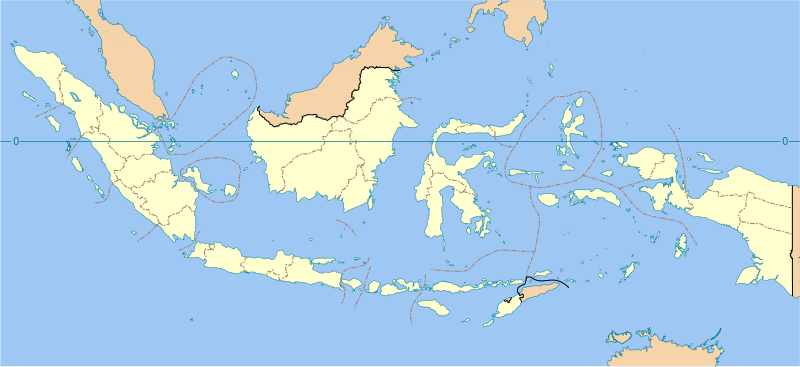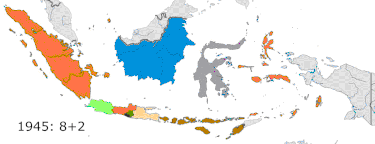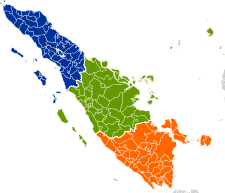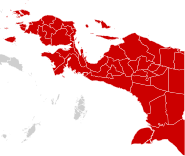Provinces are the first-level administrative divisions of Indonesia. It is formerly called the first-level provincial region (provinsi daerah tingkat I) before the Reform era. Provinces have a local government, consisting of a governor (Gubernur) and a regional legislative body (Dewan Perwakilan Rakyat Provinsi). The governor and members of local representative bodies are elected by popular vote for five-year terms, but governors can only serve for two terms. Provincial governments have the authority to regulate and manage their own government affairs, subject to the limits of the central government.
| Provinces of Indonesia Provinsi di Indonesia | |
|---|---|
 | |
| Category | First-level administrative division of a decentralized unitary state |
| Location | Republic of Indonesia |
| Created |
|
| Number | 38 |
| Populations | South Papua (522,215) – West Java (49,405,800) |
| Areas | Jakarta 661 km2 (255 sq mi) – Central Kalimantan 153,444 km2 (59,245 sq mi) |
| Government | |
| Subdivisions | |
Currently, Indonesia is divided into 38 provinces, nine of which have special autonomous status. The terminology for special status are "Istimewa" and "Khusus", which translates to 'special' or 'designated' in English. Provinces are further divided into regencies and cities (formerly called second-level region regencies and cities or kabupaten/kotamadya daerah tingkat II), which are in turn subdivided into districts (kecamatan).
Background
Article 18 paragraph 1 of the 1945 Constitution states that "the Unitary State of the Republic of Indonesia is divided into provincial regions and those provincial regions are divided into regencies and city, whereby every one of those provinces, regencies, and municipalities has its regional government, which shall be regulated by laws."
According to the Law on Regional Government (UU 23/2014) the authority of the Provincial Government includes:
- Development planning and control;
- Planning, utilization, and community peace;
- Implementation of public order and public peace;
- Provision of public facilities and infrastructure;
- Handling the health sector;
- Education and allocation of potential human resources;
- Handling social problems across regencies/cities;
- Services in the field of manpower across regencies/cities;
- Facilitating the development of cooperatives, small and medium enterprises, including across districts/cities;
- Environmental control;
- Defense services, including across regencies/cities;
- Population and civil registration services;
- Government general administration services;
- Investment administration services, including across regencies/cities;
- The implementation of other basic services that cannot be carried out by regencies/cities; and
- Other mandatory affairs mandated by laws and regulations.
The authority of the provincial government are government affairs which are located across regencies/municipalities, government affairs whose users are across regencies/municipalities, government affairs whose benefits or negative impacts lie across regencies/municipalities, government affairs which use more resources. efficient if carried out by the province.
Each province has a local government, headed by a governor and a legislative body (DPRD). The governor and members of local representative bodies are elected by popular vote for five-year terms, but governors can only serve for two terms. The general election to elect members of the DPRDs is conducted simultaneously with the national general election. Previously, the general elections for Governor and Vice Governor were not held simultaneously. However, since 2015 regional head elections have been held simultaneously. Under the plan, simultaneous partial local elections will be held in February 2017, June 2018, December 2020, culminating in simultaneous elections for all local executive posts on November 2024 and then every five years.
Current provinces
Seven provinces in Indonesia, which are "special autonomous regions" that have special characteristics, are:
 Central Papua,
Central Papua,  Highland Papua,
Highland Papua,  Papua,
Papua,  South Papua,
South Papua,  Southwest Papua, and
Southwest Papua, and  West Papua, which have their special status in the recognition and special respect for indigenous Papuans.
West Papua, which have their special status in the recognition and special respect for indigenous Papuans.
Two provinces that is a "special region" which has "privileged" characteristics:
 Special Region of Jakarta, which has the special status as the financial centre and largest city of Indonesia, and the Governor has more authority, such as appointing and dismissing regional heads in each of the 5 administrative cities and 1 administrative district, and the entire city of Jakarta.
Special Region of Jakarta, which has the special status as the financial centre and largest city of Indonesia, and the Governor has more authority, such as appointing and dismissing regional heads in each of the 5 administrative cities and 1 administrative district, and the entire city of Jakarta.
 Special Region of Yogyakarta, which has Sultan Hamengkubuwono as its hereditary governor and Adipati Paku Alam as its hereditary vice-governor. Basically a non-independent sultanate under a republic.
Special Region of Yogyakarta, which has Sultan Hamengkubuwono as its hereditary governor and Adipati Paku Alam as its hereditary vice-governor. Basically a non-independent sultanate under a republic.
One province that is another "special region" that has both characteristics:
 Aceh, which has the special and privileged status of implementation of Islamic sharia law in religious life, customary life, and education, as well as having regional parties.
Aceh, which has the special and privileged status of implementation of Islamic sharia law in religious life, customary life, and education, as well as having regional parties.
Geographical units
The provinces are officially grouped into seven geographical units for statistical and national planning purposes, but without administrative function.[1]
List of provinces

| Emblem | Name[3][4] | Reg. code | ISO[5] | Capital | Largest city | Population (mid 2022)[6] | Area km2 | Density /km2 (2022)[7] | Geographical unit | No. of Cities | No. of Reg. |
|---|---|---|---|---|---|---|---|---|---|---|---|
 | Aceh | 11 | ID-AC | 5,407,900 | 56,835 | 95 | Sumatra | 5 | 18 | ||
 | Bali | 51 | ID-BA | 4,415,100 | 5,590 | 790 | Lesser Sunda Islands | 1 | 8 | ||
 | Bangka Belitung Islands Kepulauan Bangka Belitung | 19 | ID-BB | 1,494,600 | 16,690 | 90 | Sumatra | 1 | 6 | ||
 | Banten | 36 | ID-BT | 12,252,000 | 9,353 | 1,310 | Java | 4 | 4 | ||
 | Bengkulu | 17 | ID-BE | 2,060,100 | 20,128 | 102 | Sumatra | 1 | 9 | ||
 | Central Java Jawa Tengah | 33 | ID-JT | 37,032,400 | 34,337 | 1,078 | Java | 6 | 29 | ||
 | Central Kalimantan Kalimantan Tengah | 62 | ID-KT | 2,741,100 | 153,444 | 18 | Kalimantan | 1 | 13 | ||
 | Central Papua Papua Tengah | 94 | ID-PT | Wanggar | 1,431,000 | 61,073 | 23 | Western New Guinea | 0 | 8 | |
 | Central Sulawesi Sulawesi Tengah | 72 | ID-ST | 3,066,100 | 61,606 | 50 | Sulawesi | 1 | 12 | ||
 | East Java Jawa Timur | 35 | ID-JI | 41,150,000 | 48,037 | 857 | Java | 9 | 29 | ||
 | East Kalimantan[8] Kalimantan Timur | 64 | ID-KI | 3,859,800 | 126,981 | 30 | Kalimantan | 3 | 7 | ||
 | East Nusa Tenggara Nusa Tenggara Timur | 53 | ID-NT | 5,466,300 | 46,447 | 118 | Lesser Sunda Islands | 1 | 21 | ||
 | Gorontalo | 75 | ID-GO | 1,192,700 | 12,025 | 99 | Sulawesi | 1 | 5 | ||
 | Highland Papua Papua Pegunungan | 95 | ID-PE | 1,430,500 | 51,213 | 28 | Western New Guinea | 0 | 8 | ||
 | Special Region of Jakarta Daerah Khusus Jakarta | 31 | ID-JK | 10,680,000 | 661 | 16,158 | Java | 5 | 1 | ||
 | Jambi | 15 | ID-JA | 3,631,100 | 49,027 | 74 | Sumatra | 2 | 9 | ||
 | Lampung | 18 | ID-LA | 9,176,600 | 33,570 | 273 | Sumatra | 2 | 13 | ||
 | Maluku | 81 | ID-MA | 1,881,700 | 46,158 | 41 | Maluku Islands | 2 | 9 | ||
 | North Kalimantan Kalimantan Utara | 65 | ID-KU | 727,800 | 70,101 | 10 | Kalimantan | 1 | 4 | ||
 | North Maluku Maluku Utara | 82 | ID-MU | 1,319,300 | 32,999 | 40 | Maluku Islands | 2 | 8 | ||
 | North Sulawesi Sulawesi Utara | 71 | ID-SA | 2,659,500 | 14,500 | 183 | Sulawesi | 4 | 11 | ||
 | North Sumatra Sumatera Utara | 12 | ID-SU | 15,115,200 | 72,461 | 209 | Sumatra | 8 | 25 | ||
 | Papua | 91 | ID-PA | 1,035,000 | 82,681 | 13 | Western New Guinea | 1 | 8 | ||
 | Riau | 14 | ID-RI | 6,614,400 | 89,936 | 74 | Sumatra | 2 | 10 | ||
 | Riau Islands Kepulauan Riau | 21 | ID-KR | 2,179,800 | 8,270 | 264 | Sumatra | 2 | 5 | ||
 | Southeast Sulawesi Sulawesi Tenggara | 74 | ID-SG | 2,701,700 | 36,160 | 75 | Sulawesi | 2 | 15 | ||
 | South Kalimantan Kalimantan Selatan | 63 | ID-KS | 4,182,100 | 37,135 | 113 | Kalimantan | 2 | 11 | ||
 | South Papua Papua Selatan | 93 | ID-PS | 522,200 | 117,849 | 4.4 | Western New Guinea | 0 | 4 | ||
 | South Sulawesi Sulawesi Selatan | 73 | ID-SN | 9,225,800 | 45,331 | 204 | Sulawesi | 3 | 21 | ||
 | South Sumatra Sumatera Selatan | 16 | ID-SS | 8,657,000 | 91,592 | 100 | Sumatra | 4 | 13 | ||
 | Southwest Papua Papua Barat Daya | 96 | ID-PD | 621,904 | 39,123 | 16 | Western New Guinea | 1 | 5 | ||
 | West Java Jawa Barat | 32 | ID-JB | 49,405,800 | 37,045 | 1,334 | Java | 9 | 18 | ||
 | West Kalimantan Kalimantan Barat | 61 | ID-KB | 5,541,400 | 147,037 | 38 | Kalimantan | 2 | 12 | ||
 | West Nusa Tenggara Nusa Tenggara Barat | 52 | ID-NB | 5,473,700 | 19,676 | 278 | Lesser Sunda Islands | 2 | 8 | ||
 | West Papua Papua Barat | 92 | ID-PB[9] | 561,403 | 60,275 | 9 | Western New Guinea | 0 | 7 | ||
 | West Sulawesi Sulawesi Barat | 76 | ID-SR | 1,458,600 | 16,595 | 88 | Sulawesi | 0 | 6 | ||
 | West Sumatra Sumatera Barat | 13 | ID-SB | 5,640,600 | 42,120 | 134 | Sumatra | 7 | 12 | ||
 | Special Region of Yogyakarta Daerah Istimewa Yogyakarta | 34 | ID-YO | 3,761,900 | 3,171 | 1,186 | Java | 1 | 4 | ||
Former provinces

Upon the independence of Indonesia, eight provinces were established. West Java, Central Java, East Java, and Maluku still exist as of today despite later divisions, while Sumatra, Kalimantan, Sulawesi, and Nusa Tenggara, formerly Lesser Sunda (Sunda Kecil) were fully liquidated by dividing them into new provinces. The province of Central Sumatra existed from 1948 to 1957, while East Timor was annexed as a province from 1976 until its power transfer to UNTAET in 1999 prior to its independence as a country in 2002.
| Province | Capital | Period | Successor(s) |
|---|---|---|---|
| Special Region of Surakarta (Daerah Istimewa Surakarta)[10] | Surakarta | 1945–1946 | Central Java |
| Sumatra[11] | Bukittinggi / Medan | 1945–1948 | Central Sumatra North Sumatra South Sumatra |
| Kalimantan[12] | Banjarmasin | 1945–1956 | East Kalimantan South Kalimantan West Kalimantan |
| Nusa Tenggara[13] | Singaraja | 1945–1958 | Bali East Nusa Tenggara West Nusa Tenggara |
| Sulawesi[14] | Makassar / Manado | 1945–1960 | North-Central Sulawesi South-Southeast Sulawesi |
| Central Sumatra (Sumatera Tengah)[11][15] | Bukittinggi | 1948–1957 | Jambi Riau West Sumatra |
| North-Central Sulawesi (Sulawesi Utara-Tengah)[16] | Manado | 1960–1964 | North Sulawesi Central Sulawesi |
| South-Southeast Sulawesi (Sulawesi Selatan-Tenggara)[16] | Makassar | 1960–1964 | South Sulawesi Southeast Sulawesi |
| East Timor (Timor Timur)[17] | Dili | 1976–1999 | Democratic Republic of Timor-Leste |
New provinces made from currently-existing provinces

| New province (current name) | Year | New province (then name) | Province of origin |
|---|---|---|---|
| Special Region of Yogyakarta | 1950 | Yogyakarta | Central Java |
| Aceh | 1956 | Aceh | North Sumatra |
| Central Kalimantan | 1958 | Central Kalimantan | South Kalimantan |
| Jakarta Special Capital Region | 1959 | Greater Jakarta | West Java |
| Lampung | 1964 | Lampung | South Sumatra |
| Bengkulu | 1967 | Bengkulu | South Sumatra |
| North Maluku | 1999 | North Maluku | Maluku |
| Banten | 2000 | Banten | West Java |
| Bangka Belitung Islands | 2000 | Bangka Belitung Islands | South Sumatra |
| Gorontalo | 2000 | Gorontalo | North Sulawesi |
| Riau Islands | 2002 | Riau Islands | Riau |
| West Papua | 2003 | West Irian Jaya | Irian Jaya |
| West Sulawesi | 2004 | West Sulawesi | South Sulawesi |
| North Kalimantan | 2012 | North Kalimantan | East Kalimantan |
| Central Papua | 2022 | Central Papua | Papua |
| Highland Papua | 2022 | Highland Papua | Papua |
| South Papua | 2022 | South Papua | Papua |
| Southwest Papua | 2022 | Southwest Papua | West Papua |
Renamed provinces
| Year | Old name (Indonesian) | Old name (English) | New name (Indonesian) | New name (English) | Current name |
|---|---|---|---|---|---|
| 1954 | Sunda Kecil | Lesser Sunda | Nusa Tenggara | Nusa Tenggara | non-existent |
| 1959 | Aceh | Aceh | Daerah Istimewa Aceh | Aceh Special Region | Aceh |
| 1961 | Jakarta Raya | Greater Jakarta | Daerah Khusus Ibukota Jakarta Raya | Greater Jakarta Special Capital Region | Jakarta Special Capital Region |
| 1973 | Irian Barat | West Irian | Irian Jaya | Irian Jaya | Papua |
| 1990 | Daerah Khusus Ibukota Jakarta Raya | Greater Jakarta Special Capital Region | Daerah Khusus Ibukota Jakarta | Jakarta Special Capital Region | Special Region of Jakarta |
| 2001 | Daerah Istimewa Aceh | Aceh Special Region | Nanggroë Aceh Darussalam | State of Aceh, the Abode of Peace | Aceh |
| 2002 | Irian Jaya | Irian Jaya | Papua | Papua | Papua |
| 2007 | Irian Jaya Barat | West Irian Jaya | Papua Barat | West Papua | West Papua |
| 2009 | Nanggroë Aceh Darussalam | State of Aceh, the Abode of Peace | Aceh | Aceh | Aceh |
| 2024 | Daerah Khusus Ibukota Jakarta | Jakarta Special Capital Region | Daerah Khusus Jakarta | Special Region of Jakarta | Special Region of Jakarta |
Former provincial capitals
- Tanjungpinang to Pekanbaru, Riau (until 1959)
- Jakarta to Bandung, West Java (until 1960)
- Singaraja to Denpasar, Bali (until 1960)
- Soasio, Tidore to Sukarnopura, West Irian (1956–1963)
- Dili, East Timor (1975–1999), later became the capital of Democratic Republic of Timor-Leste
- Ternate to Sofifi, North Maluku (until 2010)
- Banjarmasin to Banjarbaru, South Kalimantan (until 2022)













